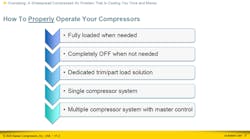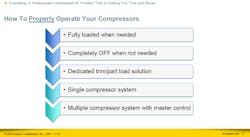During the live Q&A portion of the webinar, "Oversizing: A Widespread Compressed Air Problem That Is Costing You Time and Money," Kaeser Compressors’ engineering manager Neil Mehltretter and rotary screw compressors product manager Werner Rauer shared their knowledge on oversizing. Mehltretter has authored several nationally published articles on compressed air system optimization and is a frequent presenter on energy efficient system design. Rauer is an active leader in the Compressed Air and Gas Institute (CAGI), having helped develop the widely used CAGI compressor performance datasheets and supporting the development and implementation of ISO 11011 and EA4, the new generation of compressed air energy audit standards.
PS: How can I tell if my system is oversized?
WR: Look at the hour meters percent, low gauges, doing a quick audit, watch for large pressure swings, rapid cycling, look at capacity gauges, sometimes just hooking up one flow meter, which nowadays are inexpensive. Don't forget to also look at during the off times, which is weekends and off-seasons; for example, food processing, that would be when they harvest the product. Don't just go by this maximum, also have a solution for the off-season when you're just basically canning the tomatoes rather than processing them.
NM: I think in a lot of cases, you may be seeing something going on downstream, and you may not be going into the compressor room. Werner pretty much hit it on the head. You have to know what's going on with your equipment. You have to open the doors of the compressor room, and/or if you're continuously monitoring, you'll be able to see those key points that we talked about earlier.
PS: What are some of the ways, maybe even the simplest ways, for me to overcome an oversized system? Is there any low-hanging fruit that is common to sort of all oversized systems that people can tackle right away?
NM: You want to look at what your pressure profile is. Typically speaking, in a lot of cases, compressors will be set for maybe a seven-pound differential between load / unload. That might be too small, especially if you have a high pressure drop through your air treatment equipment. And, you know, a seven-pound pressure differential for your compressor is only ends up being a one-pound differential for the unit, so as soon as that machine unloads, it's reloading again. You really want to make sure that your differential is as wide as possible and make sure that your throughput, your piping from your compressor to anywhere inside of your compressor room is big enough, and that you can check the velocity charts for that as well. But pressure drop across air treatment could really wreak havoc on that system.
WR: Well, I have two more. Increased storage seems to be one simple solution, and another is to verify and adjust the controls that you have if you have multiple compressors. Neil mentioned spreading the ΔP, but if you have multiple compressors, then certainly also consider a master controller.

